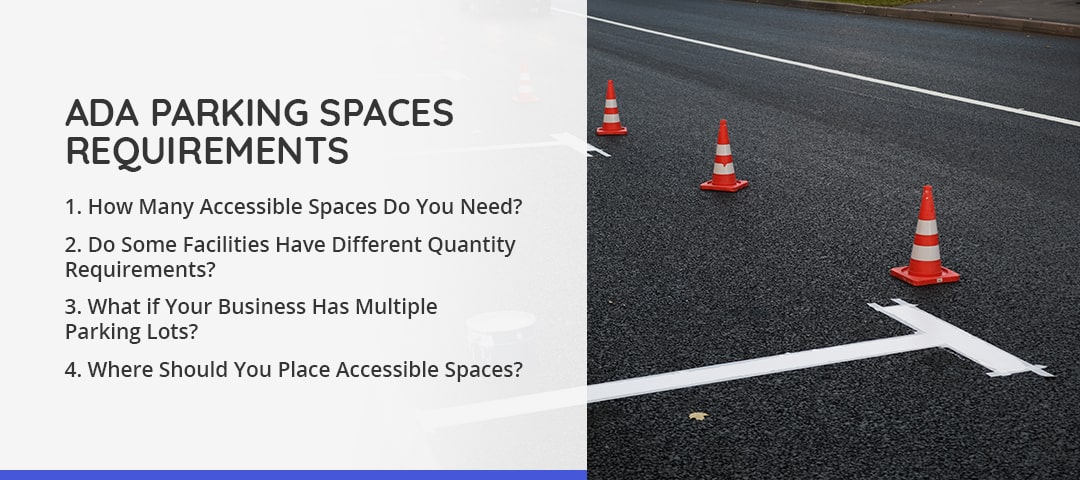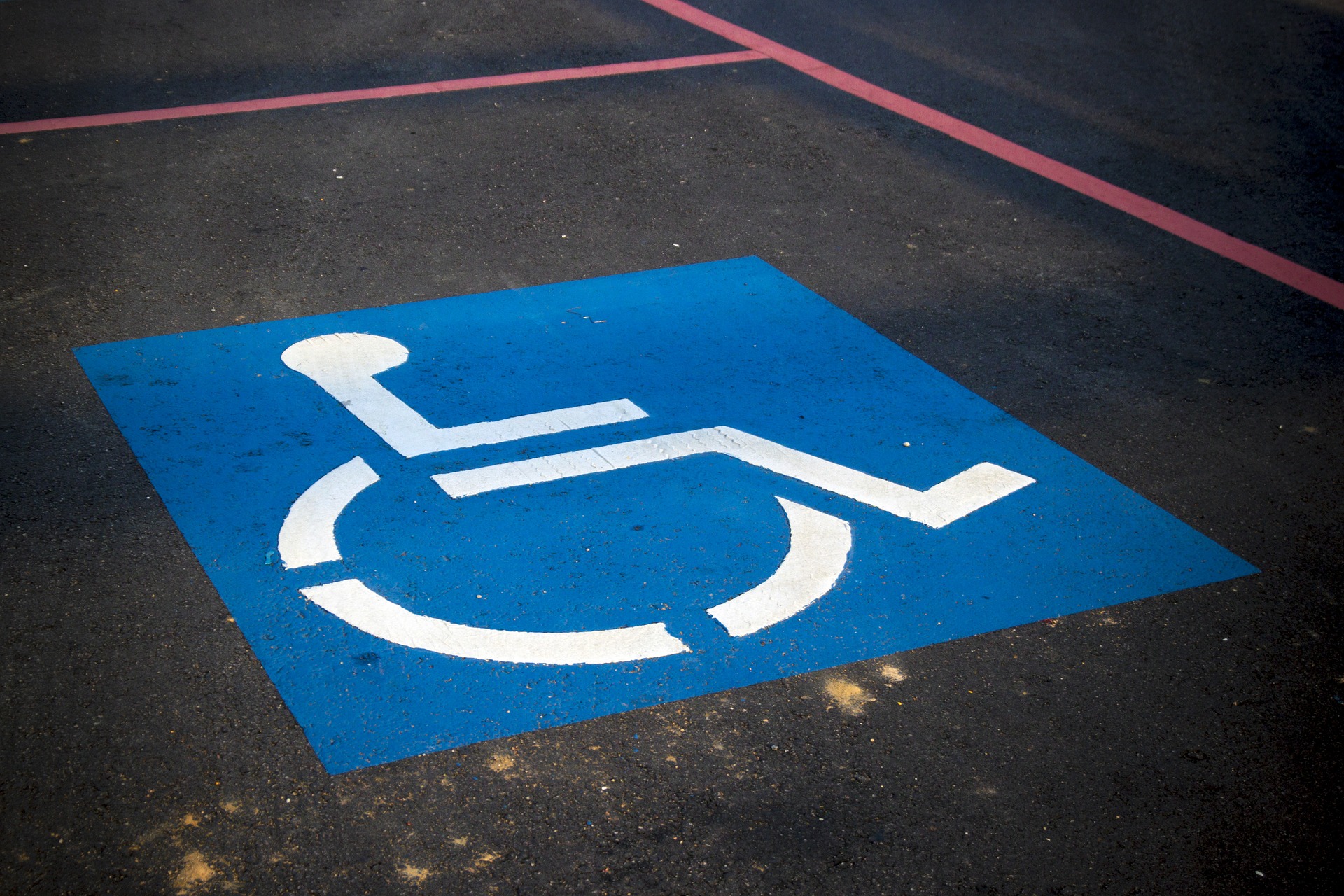Guide to California ADA Parking Requirements
Posted on: March 16, 2022 in ADA ComplianceShare:

With 26% of Americans living with a disability, creating accessible spaces is critical. Businesses and public places should follow the Americans with Disabilities Act (ADA) Standards for Accessible Design to ensure their facilities meet the minimum accessibility requirements.
One of the forefront design elements in any business or public place is the parking lot. This page provides an overview of the ADA parking lot guidelines to help your business plan accordingly.
What Is an ADA-Compliant Parking Lot?
An ADA-compliant parking lot is a space with access for people with disabilities. Every parking facility on a site should have accessible spaces, as outlined by the ADA Standards. Types of facilities that require accessible parking include:
- Public or visitor parking
- Employee parking
- Parking lots
- Parking garages
- Temporary parking lots
- Unpaved parking lots
Unpaved parking lots should feature firm, slip-resistant surfaces on accessible spaces. For example, a gravel lot — even with designated and correctly sized accessible parking — would not be accessible to someone who uses a wheelchair. However, providing wheelchair-friendly surfaces would improve accessibility.
You must ensure your parking facilities meet ADA Standards whenever you:
- Create a new parking facility.
- Build additional parking spaces.
- Resurface your lot.
ADA Parking Lot Design Requirements
If you’re constructing a new lot or altering an existing lot, ensure you meet the ADA Standards for parking lot design. The standards specify size, slope, signage and the required number of spots.
ADA Parking Lot Dimension Requirements
Accessible parking spaces must be at least 96 inches wide with a 60-inch-wide access aisle.
Each parking facility must also include a specific number of van-accessible spaces. Van-accessible spaces should be at least 132 inches wide and have a vertical clearance of 98 inches. You could also include the 36 additional inches in the access aisle.
ADA Standards for Access Aisles
All accessible spaces should have an adjacent access aisle to provide navigational space for people with disabilities. The access aisle connects the parking spot to an accessible route leading up to the building. There are guidelines for access aisles describing:
- Placement: While accessible spaces can share access aisles, each space must have an access aisle on at least one side. Angled van-accessible spots require an access aisle on the passenger side.
- Obstructions: The access aisle should contain no obstructions, including columns or signs.
- Markings: You should mark the access aisle to deter anyone from parking in it.
- Routes: Access aisles should connect the parking spot to an accessible route. Accessible routes must be at least 3 feet wide with a ramp in place of any curbs or stairs. The ramp should not obstruct the space required for an access aisle. The top of the ramp should include a 36-inch landing. Otherwise, you can construct flares along the side of the ramp to facilitate the navigation of wheelchairs onto the access path.
ADA Parking Slope Requirements
All accessible spaces, access aisles and paths must also meet slope requirements. The maximum slopes for each are:
- Parking spaces: 1:48
- Access aisles: 1:48
- Ramps and access routes: 1:12
ADA Parking Striping Requirements
When striping your parking lot, you must include deterrents in access aisles to reduce the possibility of people parking in them. For example, access aisles often feature several diagonal lines painted across the width of the space.
You’ll also need to consider whether your parking spaces will be angled or not. Accessible spaces may be angled. However, angled van spaces must include an access aisle on the passenger side. Though not required by ADA Standards, you might consider including access aisles on both sides of angled accessible spaces to improve your lot’s usability.
Generally, you should calculate each space’s required width from the center of the stripe. If the spot has no adjoining spaces or aisles on either side, you might include the stripe’s full width.
Additionally, you must mark all accessible spaces and access aisles.

ADA Parking Spaces Requirements
ADA Standards for the number and location of accessible parking spaces depend upon various factors. Four questions to help you understand the typical requirements include:
1. How Many Accessible Spaces Do You Need?
The minimum number of accessible spaces depends upon the total number of parking spots in your lot:
- Up to 100 total spaces: Lots with up to 100 total spaces require one accessible spot for every 25 total spaces. In other words, a parking lot with 25 or fewer total spaces should have at least one accessible space, while a lot with 51 to 75 total spaces needs at least three accessible spots.
- 101 to 500 total spaces: Lots with 101 to 500 total spaces should have one additional accessible space for every 50 total spots. In other words, a lot with 101 spaces would require five accessible spots, while a lot with 401 total spaces must have nine accessible spots.
- 500 to 1,000 total spaces: For lots with between 500 and 1,000 spaces, you should make 2% of the parking spots accessible.
- 1,001 or more total spaces: Any lot with over 1,000 total spaces must have a baseline of 20 accessible spaces. The lot must have an additional accessible space for every 100 spots past 1,000. For example, a lot with 1,001 total spaces must have 21 accessible spaces, while a lot with 1,201 total spaces needs at least 23 accessible spots.
Additionally, you must have at least one van-accessible space for every six accessible spots. For example, a lot with only one accessible space should make that spot van-accessible. If your parking lot has seven accessible spaces, at least two of them should be van-accessible.
2. Do Some Facilities Have Different Quantity Requirements?
Some facilities — namely, outpatient hospital facilities, physical therapy offices, mobility-focused rehabilitation centers and residential facilities — require different numbers of accessible parking spaces:
- Outpatient hospital facilities: Patient and visitor parking lots should include at least 10% accessible spaces.
- Physical therapy offices: Patient and visitor parking spaces should include at least 20% accessible spaces.
- Mobility-focused rehabilitation centers: These centers should follow the same guidelines as physical therapy offices.
- Residential facilities: If each residential unit has at least one parking spot, each accessible residence should also have at least one accessible parking spot. Non-resident parking spaces follow the standard guidelines listed above. Facilities with less than one space per unit must also follow the standard guidelines. If your facility provides more resident parking spaces than the number of units, at least 2% of the excess spots should be accessible.
3. What if Your Business Has Multiple Parking Lots?
Any business with multiple parking facilities must calculate the number of accessible spaces for each lot. In other words, if your business contains a parking garage with 600 total spaces and a standard parking lot with 150 spaces, your garage should have 12 accessible spots, and your lot should have five accessible spots. These guidelines also apply to businesses with parking lots separated by a street or distinct parking lots for different on-site buildings.
4. Where Should You Place Accessible Spaces?
Accessible spaces should connect to the shortest accessible route to each accessible entrance. In other words, if your business has multiple accessible entrances, arrange your accessible parking spots to provide balanced access to each entrance. For example, you might place half of your accessible parking spots along the path to the front entrance and half along the route to the back entrance.
ADA Parking Signage Requirements
All accessible spaces must feature a sign designating them as accessible spaces. The signs must include the Internal Symbol of Accessibility (ISA) and be at least 60 inches from the ground. Van-accessible spaces should also state “van accessible,” but these spaces are not restricted to vans only.
Choose Maintco Corp for ADA-Compliant Parking Lots
Are you building a new parking lot for your business or adding to an existing lot? If so, you must comply with ADA Standards. Maintco Corp’s construction experts are familiar with the ADA parking lot requirements and can help you stay compliant. Learn more about our ADA compliance services today. If you’re ready to talk to our team about how we can help you construct an ADA-compliant parking lot, call us at 818-276-6300 or contact us online today!

Choose Maintco Corp for ADA-Compliant Parking Lots
Are you building a new parking lot for your business or adding to an existing lot? If so, you must comply with ADA Standards. Maintco Corp’s construction experts are familiar with the ADA parking lot requirements and can help you stay compliant. Learn more about our ADA compliance services today. If you’re ready to talk to our team about how we can help you construct an ADA-compliant parking lot, call us at 818-276-6300 or contact us online today!




